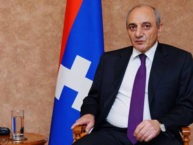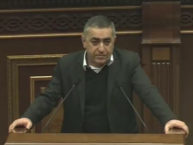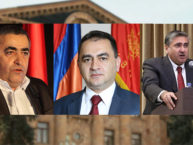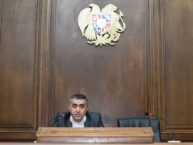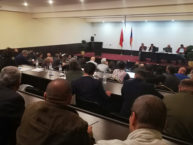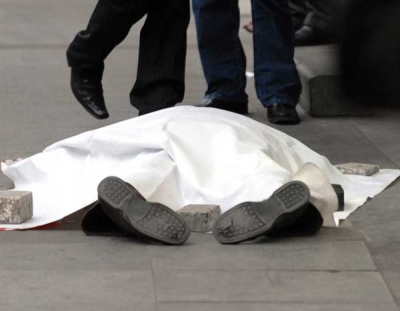
Hrant Dink, the former editor-in-chief of the Armenian Agos newspaper, was gunned down by a hard-line nationalist teenager in front of his office on Jan. 19, 2007.
STRASBOURG — Turkey failed in its duty to protect the life of slain Turkish-Armenian journalist Hrant Dink and to effectively investigate his murder, the European Court of Human Rights declared on Tuesday [Sept. 14, a day before Dink’s 56th birthday]. In a long-awaited ruling endorsed unanimously, the court also included a reference to possible links between the 2007 murder of Dink and Ergenekon, a clandestine terrorist group accused of plotting a military coup against the government.
The Strasbourg-based court’s ruling, which also ruled that Turkey violated Dink’s freedom of expression, came amid widespread calls that the ongoing trial at an İstanbul court should also include state officials, as there was strong evidence to suggest that some officials in the police and gendarmerie knew about the murder in advance but took no action to prevent it.
Lawyers for Dink’s family want possible links between Ergenekon suspects and the Dink murder to be investigated. Recent evidence has shown that some defendants in the Ergenekon case were in contact with suspects in the Dink case.
The court said the police in both Trabzon — the hometown of the assailant, Ogün Samast — and İstanbul, and the Trabzon gendarmerie, had been informed of the likelihood of an assassination attempt, and even of the identity of the suspected instigators.
“In view of the circumstances, the threat of an assassination could be said to have been real and imminent,” the court said in a statement.
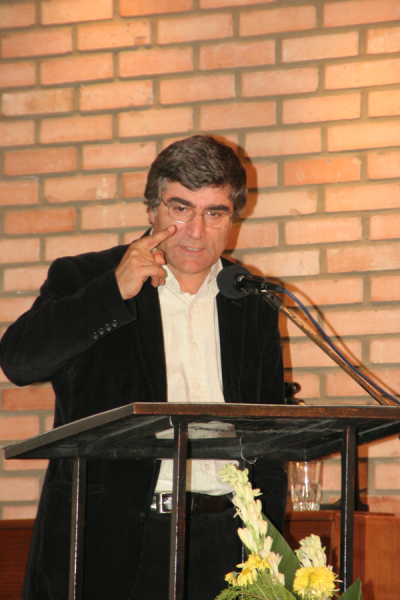
The court further noted that “none of the three state authorities informed of the planned assassination and its imminent realization had taken action to prevent it.” The judges also dismissed the Turkish state’s argument that they had not provide Dink with police protection because he had not requested it, by saying Dink could not possibly have known about the plan to assassinate him and it was the Turkish authorities’ — who were informed of the plan — responsibility to take action to safeguard his life.
Arzu Becerik, a lawyer for the Dink family, said the top court had agreed with their complaints that state officials were not prosecuted despite evidence showing their involvement in the murder. “Our efforts will not stop until those officials are brought to justice and punished,” she said in televised remarks on Tuesday.
Dink was shot dead in front of the office of his newspaper, Agos, in broad daylight. The murder outraged many Turks and sparked a massive demonstration attended by tens of thousands of people on the day of his funeral. Demonstrators carried posters that read “we are all Hrant Dink” and “we are all Armenians.” Public frustration grew further after Dink’s death when it emerged that the teenage gunman was given a hero’s welcome at a police station following his detention, with officers taking pictures with Samast who was holding a Turkish flag.
Dink was convicted in 2005 for “insulting Turkishness” in a newspaper article, despite an expert report that he had not committed the said charge. He received threats from extremist rightist groups and ultranationalist circles until he was shot dead on Jan. 19, 2007.
The ruling came in response to five different applications by Dink before his death — on the grounds that his freedom of expression was violated — and his family following his assassination, claiming that Dink’s trial on charges of insulting Turkishness had made him a target of extreme nationalist groups. The applications were later merged.
The court said in the ruling that Turkey violated three articles of the European Convention on Human Rights, namely Article 2 (right to life, lack of an effective investigation), Article 10 (freedom of expression) and Article 13 (right to an effective remedy) in conjunction with Article 2. It sentenced Turkey to pay 105,000 euros to Dink’s family in compensation and another 28,595 euros to the court for expenses.
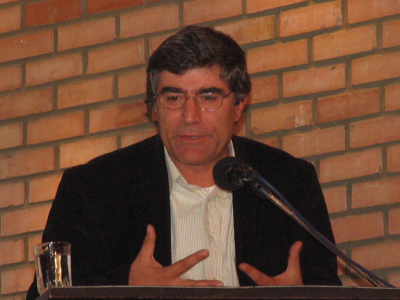
The court ruling also indicated that a controversial argument presented by Turkey’s defense failed to persuade judges in Strasbourg that Dink’s freedom of expression had not been violated. In the official defense of the Turkish state, lawyers cited the case of a leader of a neo-Nazi organization in Europe, while defending the trial of Dink under Article 301 of the Turkish Penal Code (TCK). The disclosure of the defense brought embarrassment to the government, which says it is committed to advancing freedoms. Foreign Minister Ahmet Davutoğlu later said he had not seen the text of the defense and that he regretted the Nazi reference.
In a statement following the release of the court’s verdict, the Foreign Ministry vowed to take measures to prevent the repetition of similar violations in future. The statement also said Turkey would not appeal the verdict.
The European Court of Human Rights agreed with Dink’s family that his conviction under Article 301, later upheld by the Court of Appeals, “made him a target of extreme nationalists.”
Dink faced trial after he wrote “the purified blood that will replace the blood poisoned by the ‘Turk’ can be found in the noble vein linking Armenians to Armenia, provided that the former are aware of it” in an article. The court said an analysis of the full series of articles in which Dink used the impugned expression showed clearly that what he described as “poison” had not been “Turkish blood”, as held by the Court of Appeals, but the “perception of Turkish people” by Armenians and the obsessive nature of the Armenian diaspora’s campaign to have Turkey recognize Armenian claims of genocide during the late Ottoman Empire.
15 September 2010, Wednesday
TODAY’S ZAMAN İSTANBUL
Below is the official press release
654
14.09.2010
Press release issued by the Registrar
Chamber judgment
Not final1
Dink v. Turkey (applications no. 2668/07, 6102/08, 30079/08, 7072/09 and 7124/09)
THE AUTHORITIES FAILED IN THEIR DUTY TO PROTECT THE LIFE AND FREEDOM OF EXPRESSION OF THE JOURNALIST FIRAT (HRANT) DINK
Unanimously:
Two violations of Article 2 (right to life – lack of an effective investigation),
violation of Article 10 (freedom of expression) and
violation of Article 13 (right to an effective remedy) in conjunction with Article 2
of the European Convention on Human Rights
Principal facts
The applicants are six Turkish nationals: Fırat Dink, who was known under the pen name of Hrant Dink, his wife (Rahil Dink), his brother (Hasrof Dink) and Fırat and Rahil Dink’s three children (Delal Dink, Arat Dink and Sera Dink). Fırat Dink was born in 1954 and was assassinated on 19 January 2007. The remaining applicants were born in 1959, 1957, 1978, 1979 and 1986 respectively and live in Istanbul. Fırat Dink, a Turkish journalist of Armenian origin, was publication director and editor-in-chief ofAgos, a bilingual Turkish-Armenian weekly newspaper published in Istanbul since 1996.
Between November 2003 and February 2004 Fırat Dink published eight articles in Agos in which he expressed his views on the identity of Turkish citizens of Armenian origin. In particular, in the sixth and seventh articles of the series, he wrote that Armenians’ obsession with having their status as victims of genocide recognised had become their raison d’être, that this need on their part was treated with indifference by Turkish people and that this explained why the traumas suffered by the Armenians remained a live issue. In his view, the Turkish element in Armenian identity was both a poison and an antidote. He added that Armenian identity could come to terms with its Turkish component in one of two ways. Either Turkish people could display empathy towards Armenians – something that would be difficult to achieve in the short term – or the Armenians could come to terms with the Turkish element by characterising the events of 1915 in a manner independent of the characterisation accepted by the world at large and by Turkish people. In the eighth article Mr Dink, pursuing the line of argument begun in the rest of the series, wrote that “the purified blood that will replace the blood poisoned by the ‘Turk’ can be found in the noble vein linking Armenians to Armenia, provided that the former are aware of it.” Mr Dink was of the view that the Armenian authorities should make more active efforts to strengthen ties with the country’s diaspora, as a basis for a healthier national identity. He published a further article in which he referred to the Armenian origins of Atatürk’s adoptive daughter. Extreme nationalist groups responded to the articles by staging demonstrations and writing threatening letters.
In February 2004 a nationalist extremist lodged a criminal complaint against Fırat Dink, alleging that the latter had insulted Turkish people with his use of the phrase “the purified blood that will replace the blood poisoned by the ‘Turk’ can be found in the noble vein linking Armenians to Armenia”. In April 2004 the Şişli (Istanbul) public prosecutor’s office instituted criminal proceedings against Fırat Dink under the article of the Turkish Criminal Code which made it an offence to denigrate “Turkishness” (Türklük) (Turkish identity). In May 2005 an expert report concluded that Fırat Dink’s remarks had not insulted or denigrated anyone, since what he had described as “poison” was not Turkish blood, but rather Armenians’ obsession with securing recognition that the events of 1915 amounted to genocide. In October 2005 the Şişli Criminal Court found Mr Dink guilty of denigrating Turkish identity and sentenced him to six months’ imprisonment, suspended. The court held that the public could not be expected to read the whole series of articles in order to grasp the real meaning of his remarks. On 1 May 2006 the Court of Cassation (Ninth Criminal Division) upheld the guilty verdict. On 6 June 2006 Principal State Counsel at the Court of Cassation lodged an extraordinary appeal on points of law, arguing that Mr Dink’s remarks had been incorrectly construed and that his freedom of expression should be protected. On 11 July 2006 the appeal was dismissed by the Court of Cassation sitting as a full criminal court. On 12 March 2007 the Criminal Court to which the case had been remitted discontinued the proceedings on account of the death of Fırat Dink.
On 19 January 2007 Fırat Dink was killed by three bullets to the head. The suspected perpetrator was arrested in Samsun (Turkey). In April 2007 the Istanbul public prosecutor’s office instituted criminal proceedings against 18 accused. The proceedings are still pending.
In February 2007 investigators from the Ministry of the Interior and the gendarmerie opened an investigation in order to ascertain whether the Trabzon gendarmerie had been negligent or had failed in their duty to prevent the killing, given that an informant claimed to have warned two non-commissioned officers (NCOs) of the gendarmerie about the intended crime. The gendarmes denied having been informed about the preparations for the killing. The Trabzon provincial governor’s office authorised the institution of criminal proceedings against the two NCOs but not against their superior officers. The NCOs eventually admitted that an informant had warned them of a possible killing; they claimed to have passed on all the details to their superior officers, who had been responsible for acting on the information received. The NCOs further stated that they had been ordered by their superior officers during the investigation to deny having received the information. The proceedings in question are still in progress.
The Istanbul public prosecutor’s office also requested the Trabzon public prosecutor to start proceedings against the police authorities in Trabzon, on the ground that one of the accused, who was an informant of the Trabzon police, had also provided the latter with information on the preparations for the killing. The Trabzon police authorities had made no attempt to thwart these plans but had confined themselves to officially informing the Istanbul police of the likelihood of an assassination attempt. The Istanbul public prosecutor added that one of the Trabzon police chiefs had openly voiced extreme nationalist views and supported the accused. On 10 January 2008 the Trabzon prosecuting authorities decided to take no further action against the Trabzon police, noting in particular that the accusations made by the Istanbul public prosecutor had been based on a statement by one of the accused which had later been retracted. The prosecuting authorities were persuaded by the argument that the Trabzon police had not judged the information received to be credible. Finally, they stressed that the police chief suspected of supporting the defendants’ actions had denied the accusations against him. An objection lodged by the applicants against the decision to take no further action was dismissed.
The investigation by the Istanbul public prosecutor’s office confirmed that on 17 February 2006 the Trabzon police had officially informed the Istanbul police of the likelihood that Fırat Dink would be assassinated and had identified the suspects. The Istanbul police had not acted upon this information. Following the conclusions of three investigations into this failure to act, the management board of the Istanbul provincial governor’s office decided to bring criminal proceedings for negligence against certain members of the Istanbul police authorities. However, the Istanbul Regional Administrative Court of Appeal set aside the corresponding orders on the ground that the investigation had been inadequate.
Finally, following a complaint by the applicants, a criminal investigation was opened concerning members of the Samsun police and gendarmerie on charges of defending the crime. While the suspected perpetrator was in police custody the persons concerned had had their photograph taken with the suspect, who was seen holding a Turkish flag: on the wall behind them were the words “Our country is sacred – its future cannot be left to chance”. In June 2007 the Samsun public prosecutor’s office decided to discontinue the proceedings against the officers in question, taking the view that defending a crime was only an offence if it was done in public. However, disciplinary action was taken against the officers.
Complaints, procedure and composition of the Court
Relying in particular on Article 2, the applicants other than Fırat Dink complained that the State had failed in its obligation to protect the life of Fırat Dink. Under the same provision, they alleged that the criminal proceedings brought against the State agents concerned for failing to protect the journalist’s life had been ineffective. On the latter point they also relied on Article 13. Under Article 10 in particular, they further alleged that the fact that Fırat Dink had been found guilty of denigrating Turkish identity had infringed his freedom of expression and made him a target for nationalist extremists.
The first application was lodged with the European Court of Human Rights on 11 January 2007 by Fırat Dink. The remaining applications were lodged on 18 December 2007 and 21 May, 27 November and 22 December 2008 respectively by Rahil, Delal, Arat and Sera Dink following the first applicant’s death. In application no. 7072/09, Hasrof Dink is also an applicant.
Judgment was given by a Chamber of seven judges, composed as follows:
Françoise Tulkens (Belgium), President,
Ireneu Cabral Barreto (Portugal),
Dragoljub Popović (Serbia),
András Sajó (Hungary),
Nona Tsotsoria (Georgia),
Işıl Karakaş (Turkey),
Guido Raimondi (Italy), judges,
and also Stan Naismith, Section Registrar.
Decision of the Court
Complaint concerning the alleged failure of the Turkish State to protect the life of Fırat Dink (Article 2)
The Court took the view that the Turkish security forces could reasonably be considered to have been aware of the intense hostility towards Fırat Dink in nationalist circles. The investigations carried out by the Istanbul public prosecutor’s office and the Interior Ministry investigators had highlighted the fact that the police in both Trabzon and Istanbul, and the Trabzon gendarmerie, had been informed of the likelihood of an assassination attempt and even of the identity of the suspected instigators. In view of the circumstances, the threat of an assassination could be said to have been real and imminent.
The Court next considered whether the authorities had done everything that could reasonably have been expected of them to prevent Fırat Dink’s assassination. None of the three authorities informed of the planned assassination and its imminent realisation had taken action to prevent it. Admittedly, as stressed by the Turkish Government, Fırat Dink had not requested police protection. However, he could not possibly have known about the plan to assassinate him. It had been for the Turkish authorities, who were informed of the plan, to take action to safeguard Fırat Dink’s life.
There had therefore been a violation of Article 2 (in its “substantive aspect”).
Complaint concerning the alleged ineffectiveness of the criminal investigations (Article 2)
The Court examined the criminal proceedings instituted following the careful and detailed investigation into the way in which the Trabzon and Istanbul security forces had managed the information received on the planned assassination.
It noted first of all that the provincial governor’s office had refused to authorise criminal proceedings against the Trabzon gendarmerie officers, with the exception of two NCOs. No judicial ruling had been given on the reasons why the officers competent to take the appropriate steps following transmission of the information by the NCOs had failed to take action. In addition, the NCOs had been forced to give false statements to the investigators. This was a case of a manifest breach of the duty to take steps to gather evidence concerning the events in question and of concerted action to hamper the capacity of the investigation to establish who was responsible.
As to the failures imputed to the Trabzon police, the Court observed that the Trabzon prosecuting authorities’ decision to take no further action had been based on arguments which were contradicted by other evidence in the case file. In particular, the public prosecutor had taken the view that the police officers had not judged the information received on the planned assassination to be credible, whereas in fact they had informed the Istanbul police that an assassination attempt was imminent. Furthermore, the decision not to proceed with the charges against the chief of police had not been based on any investigation. Taken overall, the prosecuting authorities’ investigation had amounted to little more than a defence of the police officers concerned, without providing any answers to the question of their failure to take action vis-à-vis the suspected assassins.
With regard to the failures imputed to the Istanbul police, the Court noted that no criminal proceedings had been started against them either, despite the findings of the Interior Ministry investigators to the effect that the police authorities had not taken the measures which the situation required. No explanation had been provided as to why the Istanbul police had not responded to the threat.
The Court acknowledged that criminal proceedings were still in progress against the suspected perpetrators of the attack. However, it could not but note that all the proceedings in which the authorities were implicated had been discontinued (with the exception of the proceedings against two NCOs in Trabzon, although this did nothing to alter the Court’s conclusion).
Lastly, the Court observed that the investigations concerning the Trabzon gendarmerie and the Istanbul police had been conducted by officials belonging to the executive, and that the dead man’s relatives had not been involved in the proceedings, a fact which served to undermine the investigations. The suspicion that one of the police chiefs had supported the accused’s actions did not appear to have been the subject of detailed investigation either.
There had therefore been a breach of Article 2 (in its “procedural aspect”), as no effective investigation had been carried out into the failures which occurred in protecting the life of Fırat Dink.
Complaint concerning Fırat Dink’s freedom of expression (Article 10)
The Turkish Government contended that there had been no breach of Fırat Dink’s right to freedom of expression since at the time of his death he had not been finally convicted. The Court stressed, however, that at the time Fırat Dink died, the highest criminal court had upheld the finding that he was guilty of denigrating Turkish identity. Moreover, this finding had made him a target for extreme nationalists, and the Turkish authorities, who had been informed of the plot to kill him, had not taken steps to protect him. There had therefore been interference with the exercise of Fırat Dink’s right to freedom of expression. According to the Court’s case-law, such interference was acceptable if it was prescribed by law, pursued a “legitimate aim” and could be regarded as “necessary in a democratic society”. The Court doubted whether it had satisfied the first two criteria, but concentrated its reasoning on the third criterion.
The Court shared the view of Principal State Counsel at the Court of Cassation that an analysis of the full series of articles in which Fırat Dink used the impugned expression showed clearly that what he described as “poison” had not been “Turkish blood”, as held by the Court of Cassation, but the “perception of Turkish people” by Armenians and the obsessive nature of the Armenian diaspora’s campaign to have Turkey recognise the events of 1915 as genocide. After analysing the manner in which the Court of Cassation had interpreted and given practical expression to the notion of Turkish identity, the Court concluded that, in reality, it had indirectly punished Fırat Dink for criticising the State institutions’ denial of the view that the events of 1915 amounted to genocide. The Court reiterated that Article 10 of the Convention prohibited restrictions on freedom of expression in the sphere of political debate and issues of public interest, and that the limits of acceptable criticism were wider for the Government than for a private individual. It further observed that the author had been writing in his capacity as a journalist on an issue of public concern. Lastly, it reiterated that it was an integral part of freedom of expression to seek historical truth. The Court therefore concluded that Fırat Dink’s conviction for denigrating Turkish identity had not answered any “pressing social need”.
The Court also stressed that States were required to create a favourable environment for participation in public debate by all the persons concerned, enabling them to express their opinions and ideas without fear. In a case like the present one, the State must not just refrain from any interference with the individual’s freedom of expression, but was also under a “positive obligation” to protect his or her right to freedom of expression against attack, including by private individuals. In view of its findings concerning the authorities’ failure to protect Fırat Dink against the attack by members of an extreme nationalist group and concerning the guilty verdict handed down in the absence of a “pressing social need”, the Court concluded that Turkey’s “positive obligations” with regard to Fırat Dink’s freedom of expression had not been complied with.
There had therefore been a violation of Article 10.
Complaint concerning the alleged lack of an effective remedy (Article 13 in conjunction with Article 2)
In cases concerning the right to life, Article 13 required not only the payment of compensation where appropriate, but also an in-depth and effective investigation capable of leading to the identification and punishment of those responsible and encompassing effective access for the family to the investigation (this went beyond the obligation to conduct an effective investigation imposed by Article 2). The lack of an effective criminal investigation in this case therefore led the Court to find that there had also been a violation of Article 13 of the Convention taken in conjunction with Article 2, as the applicants had thereby been denied access to other remedies available in theory, such as a claim for damages.
Just satisfaction (Article 41)
The Court held, in respect of non-pecuniary damage, that Turkey was to pay 100,000 euros (EUR) jointly to Fırat Dink’s wife and children and EUR 5,000 to his brother. It was also to pay EUR 28,595 to the applicants jointly for costs and expenses.
Judge Sajó, joined by Judge Tsotsoria, expressed a separate opinion which is appended to the judgment.
***
The judgment is available in French only. This press release is a document produced by the Registry. It does not bind the Court. Decisions, judgments and further information about the Court can be found on its Internet site. To receive the Court’s press releases, you can subscribe to the Court’s RSS feeds.
Press contacts
[email protected] / +33 3 90 21 42 08
Frédéric Dolt (tel: + 33 (0)3 90 21 53 39)
Emma Hellyer (telephone : +33 3 90 21 42 15)
Tracey Turner-Tretz (tel: + 33 (0)3 88 41 35 30)
Kristina Pencheva-Malinowski (tel: + 33 (0)3 88 41 35 70)
Céline Menu-Lange (tel: + 33 (0)3 90 21 58 77)
Nina Salomon (tel: + 33 (0)3 90 21 49 79)
The European Court of Human Rights was set up in Strasbourg by the Council of Europe Member States in 1959 to deal with alleged violations of the 1950 European Convention on Human Rights.
1 Under Articles 43 and 44 of the Convention, this Chamber judgment is not final. During the three-month period following its delivery, any party may request that the case be referred to the Grand Chamber of the Court. If such a request is made, a panel of judges considers whether the case deserves further examination. In that event, the Grand Chamber will hear the case and deliver a final judgment. If the referral request is refused, the Chamber judgment will become final on the day the request is rejected.
Once a judgment becomes final, it is transmitted to the Committee of Ministers of the Council of Europe for supervision of its execution. Further information about the execution process can be found here: www.coe.int/t/dghl/monitoring/execution.


